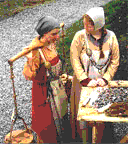
" Our popular view of the Viking Age is shaped by the sensational and
the romantic, an image of violent raiders in dragon headed ships. But who
were the Norse, the people living in Denmark, Sweden, Norway, and Iceland
at the turn of the first Millennium? Only a very few men would have gone
Viking. What was life like for the rest of the people who stayed home in
Scandinavia?
This exhibit offers you a snapshot of the daily life of these people.
Here working replicas of the artifacts shown in FULL CIRCLE - FIRST CONTACT
are placed together as you might have found them at home or in camp.


|
|
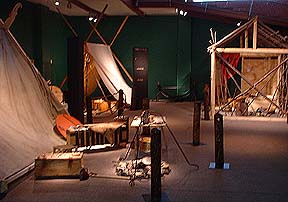
What makes individual objects from any culture interesting is their context - the stories that they can tell. The following brief notes provide some background to the individual objects included in World of the Norse. Objects are listed here in roughly the same order as you would see them inside the exhibit. Suggestions of how separate objects can be compared to other similar pieces elsewhere in the exhibit are made.
The many objects seen in World of the Norse are the work of a group of modern artisans who are interested in the forms and techniques of the Viking Age. Although the majority of pieces have been created by Darrell Markewitz of the Wareham Forge, other artists are credited for their work.
The Objects are listed in the same order and groupings as they would
be seen inside World of the Norse. In brackets after each is the
artifact prototype location / date, materials used / artisan. Those objects
that are replicas of original artifacts (or similar) seen in 'Full Circle
- First Contact' are also indicated.
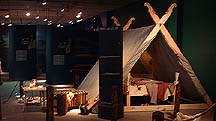
|
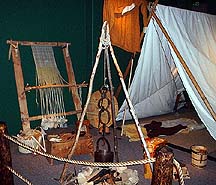
|
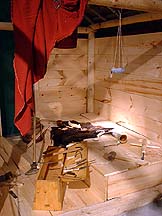
|
|
|
|
|
| |
for more information on the Viking Age... |
A note on Materials:
The objects created for World of the Norse are mostly 'replica'
grade. In this they conform to the general appearances of items from the
Viking Age, but may differ in fine detail from the original artifact prototypes.
Generally both modern and period tools and techniques have been used in
their creation, the modern techniques have been hidden where ever possible.
Raw materials are generally modern, the substitutions having been made
primarily for reasons of cost. The wood boards are all saw cut (rather
than spilt). The metal although mainly hand forged, is modern mild steel
(rather than wrought iron.) Cloth is chosen from commercial sources (rather
than all hand woven). Although all of the items seen are 'real' (ie - not
props made of plastic), all of the tools have been purposely left blunt
for safety reasons.
On the structures, modern construction details (such as fasteners)
have been used, but every attempt has been made keep these hidden.